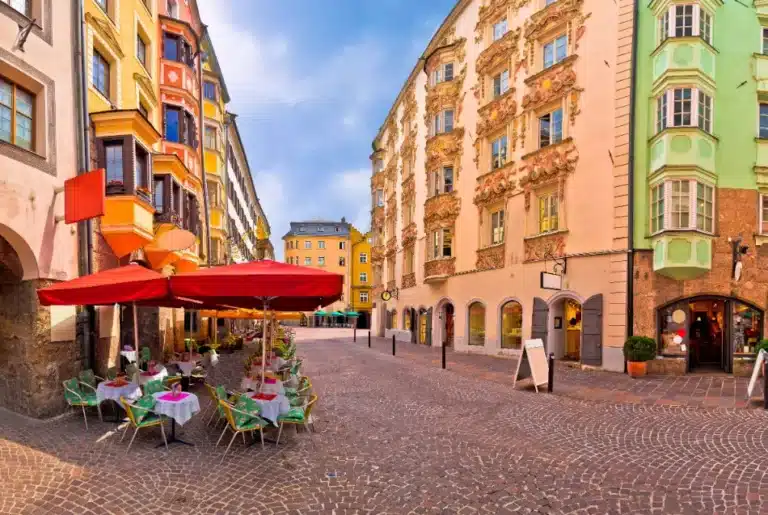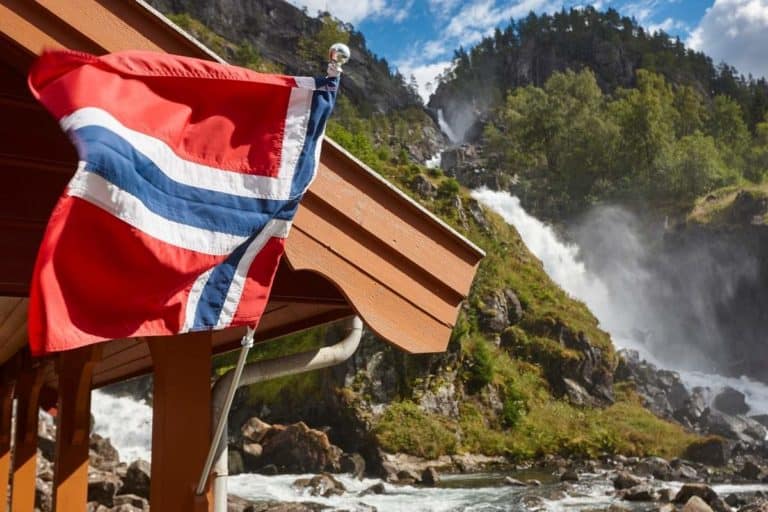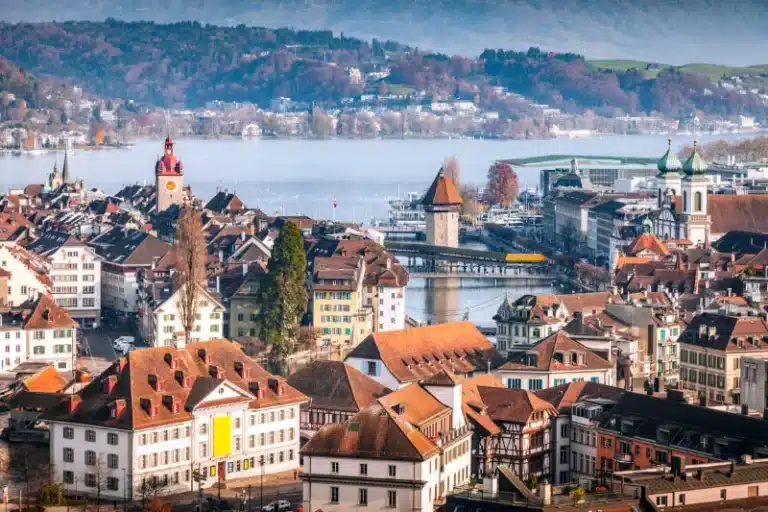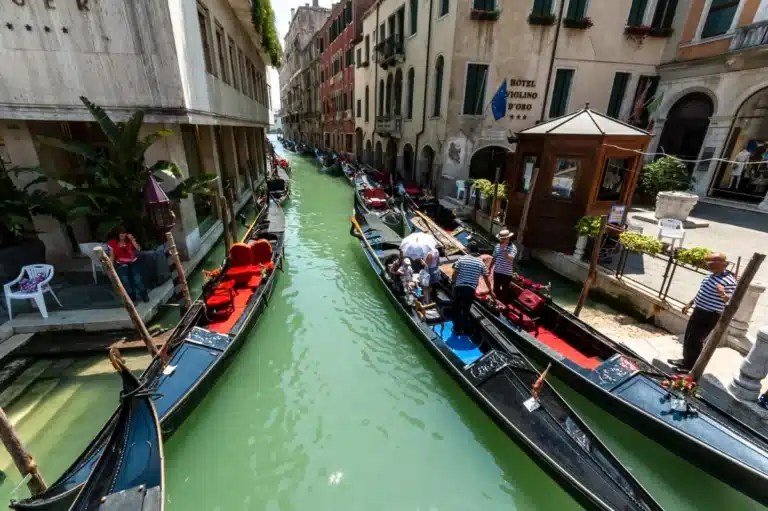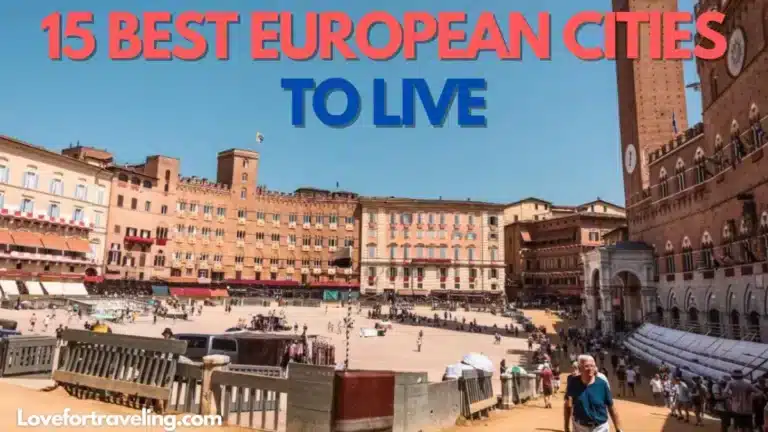Top 21 Best Cities in Denmark and some fantastic Town.
Denmark is a small country in Northern Europe. It has a population of 5.8 million, and it covers an area of 43,094 km2 (16,639 sq mi).
Copenhagen’s capital is home to the world’s oldest amusement park and one of its most iconic buildings – the 17th century Rosenborg Castle.
It’s also where you can find some of the best food in Scandinavia. In fact, it was named as one of the top 10 cities for foodies by National Geographic magazine.
Denmark also offers some great travel destinations for those looking for history or nature.
What is the prettiest part of Denmark?
This country is famous for its beautiful destinations, landscapes, and architecture. As the small country of Northern Europe, Denmark has its own incredible culture, which you can enjoy a lot when traveling in Denmark. (Here are some great attractions to visit in Denmark.)
What is the most important city in Denmark?
Copenhagen is the capital and largest city of Denmark. It’s also one of Scandinavia’s most important cities for trade, higher education, culture, finance, and science. Over a third of the Danish population lives in the Copenhagen Metropolitan area with 1 million inhabitants.
Here are the best 21 cities in Denmark!
1) Aalborg City

Aalborg is a city in the North of Jutland in Denmark with 211,000 and was founded around 1000. Today it is an important industrial center within the Danish economy. It is well developed with an excellent connection to major European cities and has lovely beaches and forests in the vicinity.
Aalborg has been ranked as a top 5 city in Denmark, with the 2nd highest score for housing and infrastructure and 8th for wellness factors. It was named “City of sports” back in 1960 due to its sports activities such as football (FCA), hockey, handball, winter sports, etc.
It is also known for its cultural events such as Aalborg Carnival and The International Documentary Festival.
Aalborg has a strong economy thanks to the significant sectors of industry and services, research institutions, education, and health care. It is home to several universities, including Aalborg University, Denmark’s second-largest university with more than 25,000 students.
Aalborg is a lovely city with many events, including the street fair, The International Documentary Festival, and the Northern Sound music festival. Its proximity to the beach makes it an ideal destination for the summer holidays.
The city has no double-decker buses, but it does have trams operating in the city center only (the metropolitan area of Aalborg is served by buses).
Aalborg has bicycle paths for all kinds of cyclists. Its 2 cycleways to the seaside offer a perfect combination of nature and traffic-free cycling.
It is a very safe city for children to grow up and learn. The education system in Aalborg is its best feature thanks to high standard schools, day-care centers, and kindergartens with services such as football training and events for young parents, etc. It has many green areas throughout the city, making it a perfect place to enjoy nature.
The city has an excellent public transportation system known as Aalborg Bus with a single fare for all buses and trams within the whole metropolitan area of Aalborg, including the neighboring municipalities of Nørresundby, Tårnby, and Frederikshavn.
It is not very expensive to live in Aalborg with very affordable accommodation and a well-developed cultural life. The city offers its citizens various sports activities, events, and support to participate in sport throughout their lives from childhood to pensioners.
Aalborg is a city with many innovative ideas and projects and therefore considered as an ideal place to live, work, or study. It has been ranked among the top 5 cities to launch your career, and Copenhagen, Aarhus, Odense, and Esbjerg.
It has all the ingredients to be called the “Northern Capital” of Europe.
2) Copenhagen City

There are many reasons why you should choose Copenhagen over other cities as a place to live in Denmark, such as its climate and weather, which is more relaxed than most parts of Southern Europe thanks to the sea winds.
It has a high quality of life, an excellent health care system, and its residents enjoy living in a city with the highest standards of education and services.
It is considered one of the top green cities in Europe, with more than 40% green areas all over Copenhagen. The city offers many sports facilities such as indoor swimming pools for children, gyms, football pitches, etc.
Copenhagen is a city of culture offering plenty of art and music events and theatres.
Several museums highlight its history, such as the Royal Danish Museum, The National Museum, Rundetårn (The Round tower).
It also has a stunning architecture that attracts tourists worldwide, especially during its many festivals organized throughout the year. It has a variety of events for families to participate in, such as carnivals and concerts.
The city offers its inhabitants an excellent education system with many high-standard schools. You can choose between international programs taught by native speakers or Danish ones, followed from 1st grade all the way up to university.
There is also a well-developed transportation system with an extensive network of rail lines and ferries. The city also has a wide range of accommodation in all categories, from holiday homes to luxury hotels.
The Danish capital is one of the most popular cities in Europe for its urban culture, aesthetic environment, and restaurants offering traditional food or the most sophisticated cuisine. It is a vibrant city with plenty of nightlife and activities to participate in.
It is also very safe for children thanks to an efficient police department which keeps crimes at a minimum.
The education system offers families many programs such as worksheets following the Danish curriculum, citizenship courses, and various sports events throughout the year for both adults and children.
3) Odense City

Odense is the third-largest city in Denmark, with 250,000 inhabitants across its metropolitan area, including nearby towns like Egedal and Assens.
It is a clean and safe city with a high standard of living and is often ranked among the top 10 cities to live in Europe.
It offers its inhabitants an extensive network of green areas, bike paths all over the city, children playgrounds with inclusive play equipment, and beautiful parks such as the Botanical Garden, which attracts tourists from around the globe.
It has a cool climate, and the average temperature in the winter is 6 degrees Celsius and in summer about 18 degrees. It has various sports facilities ranging from football pitches to indoor swimming pools, music venues, and theatres.
There are many museums such as :
- The Faaborg Museum, which highlights its history as a merchant town,
- The Funen Village where you can learn about Denmark’s agricultural past,
- The Museum of Regional History highlights its history from the 9th century, and it also has an art museum with works by Danish artists.
There are many state-of-art schools in Odense offering a high standard education system that includes bilingual programs.
The city also has a wide range of accommodation to choose from, from budget hotels to 5-star luxury villas or apartments. It is easy to travel around the city with its bus network and efficient rail services, which connect it to all major cities in Denmark, such as Copenhagen.
It has various activities for children to participate in, such as sports events and various workshops organized throughout the year. Families also have easy access to parks, playgrounds, and family-friendly museums.
4) Aarhus City

Aarhus is the second-largest city in Denmark, with 336,000 inhabitants across its metropolitan area, including nearby towns like Randers and Grenaa.
It is a safe city with a high standard of living, and it was ranked the safest city in Europe by ECA International. It has well-developed transportation networks with an extensive bus system connecting it to all neighboring towns and significant rail links to Denmark.
Every year, it attracts tourists worldwide. They are amazed by its architecture and stunning green spaces, including parks, playgrounds with inclusive play equipment, beaches, sports facilities, and other exciting places.
It has a cool climate even though temperatures do drop below zero in winter, but the summers are enjoyable, with an average temperature of 17 degrees Celsius.
Many museums, such as The Museum of Contemporary Art, which has exhibitions from international artists, Risskov House, which showcases daily life in the 19th century. It also has a beautiful art museum containing works by a famous Danish artist.
It offers a high-standard education system with bilingual programs for both adults and children, and private schools are top-rated due to their multicultural and international approaches to learning.
For example, they have a Danish school that offers students an introduction to the Danish culture with lessons in the Danish language. Children can also attend classes at its English school, where 90% of the time is spent on English and 10% Danish.
There are many activities for children to participate in, such as sports events, children’s workshops, and family days, organized throughout the year. Families also have easy access to parks, playgrounds, ponds, and other exciting places, easily accessed via the efficient bike paths in Aarhus.
5) Randers City

Randers has 60,000 inhabitants, and it is a part of the Aarhus metropolitan area.ECA International is also ranked the 3rd most liveable city in Denmark due to its calm atmosphere, safety, and various entertainment facilities, including parks, sports areas, music venues, theatres, and cinemas.
With such pleasant weather, it is not a surprise that there are many green spaces in the city with beaches, playgrounds, and parks which can be accessed via bike paths. There are also family-friendly museums such as Randers Tropical Zoo, which showcases plants and animals from tropical regions worldwide.
The city also offers many activities for children to participate in, such as sports events, kids clubs, and family festivals held throughout the year. Families can easily access public spaces with a well-developed bike path network connecting the whole city.
6) Hillerød City

Hilleroed is located just north of Copenhagen, and it is safe with an excellent quality of life. The city offers an extensive range of activities, including biking, hiking, swimming, visiting art galleries, or many family-friendly festivals such as Strings in the Park, which showcases classical music performances.
There are also various sports facilities, including tennis courts, soccer fields, and even horse riding facilities.
It is also a trendy school choice for ex-pats as bilingual programs for children in both Danish and English.
The city attracts many experts in the fields of technology, energy, and media.
There are excellent public spaces such as Egeskov Castle, surrounded by forests, lakes, and rivers. You can enjoy various activities such as visiting the aquarium, walking along a trail, or participating in any outdoor activity.
Families can also enjoy a picnic at one of the many parks around the city, such as Legindparken, where you can play tennis, jog, and have fun with other kids.
7) Horsens City
Horsens is located in west Denmark, and it has a population of 60,000. It ranks as the fourth most liveable city in Denmark by ECA International with its low crime rate, safety, and pleasant climate.
It also has numerous green spaces for families to explore, such as Gammel Estrup Park, which showcases animals from all over the world in a beautiful setting. Families can also relax in the botanical garden, play tennis at one of the four public courts or visit the nearby playgrounds, which are easily accessed by bike paths.
There are many activities for children such as visiting one of its historic castles, playing soccer, swimming or playing badminton at the local sports facilities such as Horsens Sports Centre.
It is also well-connected to public transport with buses frequently arriving in the city center and having easy access via bike paths.
8) Herning City

Herning is a part of the Viborg metropolitan area, and it has a population of 85,000, which makes it the fifth most populated city in Denmark. It is also ranked as one of the safest cities in Europe by the Numbeo Crime Index.
It boasts many family-friendly attractions, including green areas, picnic sites, playgrounds, and many festivals.
There are also many attractions for children in the city, such as zoological gardens, petting zoos, and museums that showcase animals or history.
Families can also enjoy playing in one of its parks or biking along bike paths and enjoy scenic views of green grasslands, forests, and lakes.
9) Vejle City

Vejle is located in the east of Jutland, and it is well-connected to nearby cities by bus. It offers easy access to nature with its lakeside parks, biking paths, and forested areas.
The city also has an advanced healthcare system, and it is ranked among the 5 best places to live in Denmark.
This town of over 110,000 people has a history that goes back to the 10 th century. The old part of the city is surrounded by walls, and there is also a preserved moat built in the 17 th century.
Vejle also has a castle that dates back to sometime between 1350 and 1400. And if you’re interested in learning more about the culture, there is an open-air museum here where you can see historical buildings from different parts of Denmark.
One of its leading museums, Den Gamle By, recreates an old market town from the 1800s. It also has a Viking ship museum as well as several art museums and theatres.
10) Roskilde City

Roskilde is located in the west of Denmark, and it has a population of 50,000. It also has been ranked as one of the best cities to live in by ECA international due to its picturesque setting, low crime rate, high level of education, and job opportunities.
The city offers many activities for families, such as biking around the canals, visiting museums such as Roskilde’s Viking Ship Museum, or participating in its annual Viking market.
Families can also enjoy a picnic at one of the city’s numerous parks, such as Kongens Have, where you and your children can play on the playgrounds, visit the adventure playground or spend time at the open-air museum, which is laid out in beautiful gardens.
It also has a world-renowned cathedral worth exploring and even snapping some pictures of its magnificent architecture.
This city was once the capital of Denmark until it was overtaken by Copenhagen in 1443, making it one of the oldest cities in Europe, which has preserved its royal seat. It also has a cathedral, the second biggest in Scandinavia, and a well-preserved medieval castle.
11) Kalundborg City
Kalundborg is located in the south of Denmark, and it has a population of 16,000. It offers many activities for families, including bird watching at one of its nature reserves or visiting nearby castles such as Kalundborg Castle, which offers guided tours throughout the week.
It also has a large harbor frequented by tourists to watch cruise ships arrive and depart. Several museums in the small city, such as Danish Maritime Museum, showcases Denmark’s rich maritime history.
It is an excellent place for families to exercise with its 15 public parks or bike paths that allow you to explore the many lakes, forested areas, and beaches nearby. There are also many activities for children, including horse riding, concerts, festivals, and events throughout the year.
12) Kolding City

Kolding is located in the southwest corner of Jutland, and it has a population of 57,000 people. It offers many activities for families such as shopping at its large indoor mall called Kolding Storcenter or visiting nearby castles like Mols Bjerge Nationalpark or Koldinghus, which allow guided tours.
There is also a large marina that offers sightseeing cruises, deep-sea fishing, and boat rentals for families to enjoy the scenic view of Denmark’s coastline. It is an excellent place for biking with its many bike paths and panoramic views along the way. You can also find beautiful parks and the Koldinghus Museum, which is located in a beautiful castle.
13) Sønderborg City

Denmark has a population of 27,000 people. It is one of the happiest countries in the world, according to the UN’s 2013 World Happiness Report, because its citizens enjoy high levels of life satisfaction, freedom, and trust.
It also has a well-developed economy with one of the highest living standards in the world with many well-paid and stable jobs.
14) Helsingør City

Helsingør is located in the northeast of Zealand, and it offers scenic views from its castle hill, where you can see boats sailing into the city’s harbor. It has a population of 62,000, and it is full of green spaces such as parks, lakes, and forests that offer lots of fun activities for families to do.
You can also enjoy the city’s many bicycle lanes, which allow you to explore its scenic countryside.
It is an excellent place for children to discover their artistic side with its art museums, and there are many festivals throughout the year. Families can also take a boat trip to Helsingør’s sister city, Elsinore, home to Shakespeare’s famous castle Kronborg.
15) Thisted City
Thisted is located in Thy, and it has a population of 13,000 people. It offers families a great place to enjoy the Danish countryside with its many parks and cycle paths. It is a perfect place for families who love the outdoors, water sports, or just spending time at the spa after an active day.
Many beautiful castles in the area, such as Damhus Castle, a short drive from this seaside town. Families can also enjoy bird watching or visiting one of its nature reserves for an afternoon full of hiking, fishing, and photography.
16) Fredericia City
Fredericia’s history dates back to Viking times, and it has flourished since then.
It has a population of 50,000 people, and it is an excellent place for families to spend time exploring the city’s historical sites. For example, you can visit Fredericia Nationalmuseet or stroll through its romantic gardens.
The town also offers many festivals throughout the year for children, such as Carnival with floats, parades, and music or Rasmus Klump’s Circus Festival with a magic show and acrobatics.
17) Billund City

Billund is a small Danish town located in Jutland, and it has 6,000 residents. It offers scenic views of the surrounding countryside and many agricultural activities for your children to learn about farming practices such as harvesting fruit during the summer or planting vegetables like carrots in its large community garden.
It is also a great place to learn about Danish history at the Funen Village Museum. While visiting this charming town, you can also enjoy its many festivals such as Billund Blues Festival with live concerts or visit Givskud Zoo, which has nearly 1 000 animals from around the world, including tigers, lemurs, and camels.
18) Frederikssund City

Frederikssund is located on the north coast of Zealand, and it has a population of 16,000. Many parks for families to enjoy, such as Frederiksborg Slotssø, a short drive away from the city center.
It is also home to many festivals throughout the year, such as the Midsommer Festival with music, fireworks, bonfires, or the Viking Festival held at Frederiksborg Slotssø.
19) Holstebro City
Holstebro is located in the western part of Jutland, and it has a population of 55,000. There are many parks where families can enjoy outdoor activities such as cycling or walking with their children while taking in the views of the surrounding countryside.
You can also see local craftspeople practicing traditional handicrafts and artisans renovating historic buildings at the Holstebro Husflidscenter. There are many festivals throughout the year, such as Friluftsliv Festival with music and other performances, an open-air market, and a flea market where you can purchase artisans’ handmade wares.
20) Viborg City

Viborg is the fourth largest city in Denmark, and it has a population of 66,000. It offers many parks such as Auning Sommerland, home to many rides, activities, games, and animals, or Viborg Zoo, where you can get up close with tigers, lions, and zebras.
Many museums in the area, the Viborg Museum, a national museum for the northern part of Jutland, provides a glimpse into Denmark’s past with its many exhibits and artifacts.
21) Holbæk City
This Danish town is located on the southeastern coast of Zealand, and it has a population of 22,000 people. It offers scenic views of the surrounding countryside and the beautiful Holbæk River, where you can take a boat ride and enjoy dinner on board.
Holbæk is also the birthplace of the famous sculptor Bertel Thorvaldsen who influenced art throughout Europe during his time.
The city is home to the Holbæk Museum, with many of his works and artifacts.
FAQ:
Is Denmark scenic?
Denmark is gorgeous and different from the rest of Europe.
Are people in Denmark friendly?
They are very polite and helpful, but speak no English! Also, Danes (like the Swedes) are pretty reserved and closed-minded about politics, religion, etc., so if someone asks your views on these subjects, don’t be surprised to get a frozen shoulder.
What are some Danish customs that are different from the rest of Europe?
They close businesses early (between 3 and 4) and don’t open on Sundays. Also, they go out for a coffee in the afternoons before dinner, so at about 4 pm, you can see many people sitting outside enjoying a ‘kold øl’ or two.
Is Denmark expensive?
Everything costs more than in other parts of Europe. The cost of living is higher here, too, so if you want to live it up, go for it, but be aware that there are not TONS of great bargains to be had!
What is the wealthiest city in Denmark?
Copenhagen is one of the most expensive cities in Scandinavia and has a very high cost of living.
What should I pack for a vacation to Denmark?
A jacket if you plan on going anywhere not near the coast; don’t forget your rain pants! Temperatures can vary wildly from day to night time, so layers are essential.
How many towns does Denmark have?
It is hard to say, Denmark has 243 cities/towns in total.
What are some of the main attractions in Denmark?
The scenic countryside is lovely and well-worth exploring; just be sure to pack your rain gear…and a tent for camping enthusiasts! Also, don’t miss the famous Legoland if you have kids. If you like history or science museums, there is a huge one in Copenhagen.
What are some excellent places to see while on vacation?
Denmark has many sights and destinations for visitors. Some of the best attractions include Tivoli Gardens (the oldest amusement park in Europe), Freetown Christiania, the Little Mermaid statue in Copenhagen.
Is Denmark an excellent place to live in?
Denmark is a great place to visit, but it’s not necessarily the best for living. The cost of living can be very high, and there aren’t as many jobs in Denmark as in some other European countries. Even though it ranks higher than most places on the scale, you might have a better idea from reading about Denmark’s living conditions first. Danmarks’s positives are its beautiful scenery and the cities. Some of the negatives are the high cost of living, cold climate, and a relatively low standard of living.
Conclusion:
So that is it, folks; I hope you enjoyed the list, and be sure to share it with your friends and family on Facebook or Twitter. If you want even more information about Denmark, why not check out my previous article, The 13 Best Places in Denmark for Backpackers. Thanks again!

